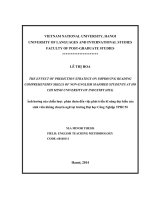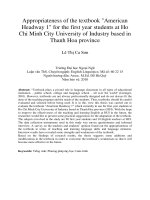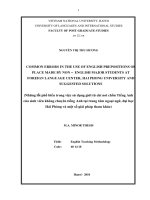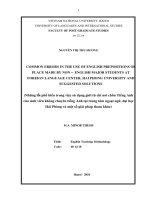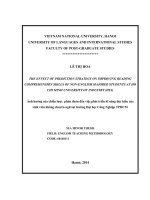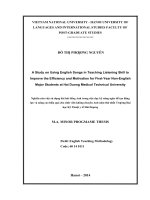Solving common intonation problems of non english major students at ho chi minh city university of science an action research study
Bạn đang xem bản rút gọn của tài liệu. Xem và tải ngay bản đầy đủ của tài liệu tại đây (1.96 MB, 138 trang )
VIETNAM NATIONAL UNIVERSITY - HO CHI MINH CITY
UNIVERSITY OF SOCIAL SCIENCES & HUMANITIES
FACULTY OF ENGLISH LINGUISTICS & LITERATURE
SOLVING COMMON INTONATION PROBLEMS
OF NON-ENGLISH MAJOR STUDENTS
AT HO CHI MINH CITY UNIVERSITY OF SCIENCE:
AN ACTION RESEARCH STUDY
A thesis submitted to the Faculty of English Linguistics and Literature
in partial fulfillment of the Master's degree in TESOL
By
PHAM DUY DUONG
Supervised by
Assoc. Prof. Dr. NGUYEN THANH TUNG
HO CHI MINH CITY, MAY 2018
ACKNOWLEDMENTS
Firstly, I would like to show my deepest gratitude to my beloved
supervisor, Assoc. Prof. Dr. Nguyen Thanh Tung, for having wholeheartedly
instructed, inspired, reminded and supported me when I conducted the study. I
do apologize profusely to him for my lateness sometimes. Without my dear
supervisor, I could not have completed my thesis on time.
Secondly, I would like to give all my heartfelt thanks to all the lecturers
at Ho Chi Minh City University of Social Sciences and Humanities and other
lecturers for teaching, guiding and imparting the knowledge to me. I have
learned a great deal of valuable knowledge from them since I was a
postgraduate at this university.
Thirdly, this thesis is highly dedicated to my parents and my two older
brothers. I owe a debt of gratitude to them. They always remind me of the
bright future after graduation and say to me "Do not ever give up and do your
best!" when I feel totally dispirited.
Next, I am extremely grateful to all my dear students and colleagues at
Ho Chi Minh City University of Science for making my thesis complete and
perfect.
Last but not least, I owe my friends, especially my closest one, special
thanks. They are always by my side to unceasingly motivate and push me
when I am on the wrong track and give me helpful pieces of advice when I do
not have sufficient motivation for completing the thesis.
Thank you all of you from the bottom of my heart!
i
STATEMENT OF ORIGINALITY
I certify that this thesis, entitled "Solving common intonation problems
of non-English major students at Ho Chi Minh City University of Science: An
action research study" is my own work.
This thesis has not been submitted for the award of any degree or
diploma in any other institution.
Ho Chi Minh City, May 2018
Pham Duy Duong
ii
RETENTION OF USE
I hereby state that I, Pham Duy Duong, being a candidate for the degree
of Master of Arts in TESOL, accept the requirements of the university related
to the retention and use of Master's Thesis deposited in the University Library.
I agree that the original of my Master's Thesis deposited in the
University Library should be accessible for the purpose of the study and
research, in accordance with the normal conditions established by the Library
for the care, loan and reproduction of theses.
Ho Chi Minh City, May 2018
Pham Duy Duong
iii
TABLE OF CONTENTS
ACKNOWLEDMENTS ............................................................................. i
STATEMENT OF ORIGINALITY ......................................................... ii
RETENTION OF USE.............................................................................. iii
TABLE OF CONTENTS .......................................................................... iv
LIST OF ABBREVIATIONS ................................................................... ix
LIST OF TABLES ..................................................................................... x
LIST OF FIGURES ................................................................................ xiii
ABSTRACT ............................................................................................. xiv
CHAPTER 1: INTRODUCTION ............................................................. 1
1.1 Background to the study .................................................................. 1
1.2 Statement of the problem ................................................................ 2
1.3 Aim and research questions ............................................................. 3
1.4 Significance of the study ................................................................. 4
1.5 Organization of the thesis ................................................................ 4
CHAPTER 2: LITERATURE REVIEW ................................................. 6
2.1 Pronunciation................................................................................... 6
2.1.1 Definitions of pronunciation ...................................................... 6
2.1.2 Aspects of pronunciation ........................................................... 7
2.1.3 Importance of pronunciation ..................................................... 8
2.2 Intonation ......................................................................................... 9
2.2.1 Definitions of intonation ............................................................ 9
2.2.2 Components of intonation ....................................................... 11
2.2.2.1 Pitch ................................................................................... 11
2.2.2.2 Word stress ........................................................................ 12
iv
2.2.2.3 Sentence stress ................................................................... 14
2.2.2.4 Tone unit ............................................................................ 16
2.2.3 Intonation patterns ................................................................... 20
2.2.3.1 Paulston and Bruder (1976) ............................................... 20
2.2.3.2 Kelly (2000) ....................................................................... 21
2.2.3.3 Kreidler (2004) .................................................................. 23
2.2.3.4 Yoshida (2013) .................................................................. 23
2.2.4 Functions of intonation ............................................................ 26
2.3 Intelligibility and its application to intonation assessment ........... 28
2.3.1 Intelligibility ............................................................................ 28
2.3.2 Applying intelligibility to intonation assessment .................... 29
2.4 Intonation teaching techniques ...................................................... 30
2.4.1 Using videos ............................................................................ 30
2.4.2 Using Coolspeech .................................................................... 31
2.4.3 Using Speech Analyzer ........................................................... 31
2.5 Review of previous studies............................................................ 31
2.6 Chapter summary .......................................................................... 33
CHAPTER 3: METHODOLOGY .......................................................... 34
3.1 Research site .................................................................................. 34
3.2 Participants .................................................................................... 35
3.3 Research methodology .................................................................. 36
3.3.1 Research approach ................................................................... 36
3.3.2 Research method...................................................................... 37
3.3.2.1 Reasons for choosing action research ................................ 37
3.3.2.2 Applying action research to the study ............................... 38
v
3.3.3 Research instruments ............................................................... 40
3.3.3.1 Questionnaires ................................................................... 40
3.3.3.2 Tests ................................................................................... 41
3.4 Analytical framework .................................................................... 43
3.4.1 Questionnaires ......................................................................... 43
3.4.2 Tests ......................................................................................... 43
3.5 Validity and reliability................................................................... 48
3.5.1 Questionnaires ......................................................................... 48
3.5.2 Tests ......................................................................................... 48
3.6 Chapter summary .......................................................................... 49
CHAPTER 4: RESULTS AND DISCUSSION ..................................... 50
4.1 Data analysis .................................................................................. 50
4.1.1 Results from the two questionnaires ........................................ 50
4.1.1.1 Results from the pre-questionnaire .................................... 50
4.1.1.2 Results from the post-questionnaire .................................. 59
4.1.1.3 Comparison of pre- and post-questionnaires ..................... 64
4.1.1.4 Results from the two mini-tests of the two questionnaires 67
4.1.2 Results from the two tests ........................................................ 67
4.1.2.1 Inter-rater reliability........................................................... 67
4.1.2.2 Tests data analysis ............................................................. 71
4.2 Discussion of the findings ............................................................. 76
4.2.1 Findings about the students' attitudes towards learning
intonation ............................................................................................ 76
4.2.2 Findings about the students' intonation performance .............. 77
CHAPTER 5: CONCLUSION ................................................................ 80
5.1 Conclusion ..................................................................................... 80
vi
5.2 Evaluation of research methodology ............................................. 81
5.2.1 Strengths .................................................................................. 81
5.2.2 Weaknesses .............................................................................. 82
5.3 Recommendations ......................................................................... 82
5.3.1 For the teachers ........................................................................ 82
5.3.2 For the students ........................................................................ 83
5.3.3 For the schools ......................................................................... 83
5.4 Suggestions for further research .................................................... 84
5.5 Chapter summary .......................................................................... 84
REFERENCES ......................................................................................... 85
APPENDICES .......................................................................................... 88
(Pre-questionnaire) .............. 89
APPENDIX 2: Pre-questionnaire ........................................................... 94
(Post-questionnaire) ............. 98
APPENDIX 4: Post-questionnaire ........................................................ 102
APPENDIX 5: Intonation test (Pre-test) .............................................. 105
APPENDIX 6: Intonation test (Post-test) ............................................ 107
APPENDIX 7: Pre-test assessment ....................................................... 109
APPENDIX 8: Post-test assessment ..................................................... 112
APPENDIX 9: Criteria for intonation assessment .............................. 115
APPENDIX 10: Raw scores by Examiner 1 ........................................ 116
APPENDIX 11: Raw scores by Examiner 2 ........................................ 117
APPENDIX 12: Total scores by Examiner 1 ....................................... 118
APPENDIX 13: Total scores by Examiner 2 ....................................... 119
APPENDIX 14: Mean scores by the two examiners ........................... 120
vii
APPENDIX 15: General improvement of students ............................ 121
APPENDIX 16: Mean scores of the four types by the two examiners122
APPENDIX 17: Students' improvement for each type ....................... 123
viii
LIST OF ABBREVIATIONS
AR
: Action research
HCMUS : Ho Chi Minh City University of Science
SPSS
: The statistical package for the social sciences
ix
LIST OF TABLES
Table 2.1: Definitions of intonation by Kenworthy (1987), Roach (1991),
Kelly (2000), Kreidler (2004), Knight (2012) and Yoshida (2013). 11
Table 2.2: Examples of word stress by Kelly (2000) .................................. 12
Table 2.3: Content words and function words by Yoshida (2013) .............. 15
Table 2.4: Intonation patterns by Kelly (2000)............................................ 22
Table 2.5: Intonation patterns by Kreidler (2004) ....................................... 23
Table 2.6: A summary of functions of intonation ........................................ 27
Table 3.1: Students' personal information ................................................... 35
Table 3.2: Teaching procedures ................................................................... 39
Table 3.3: A summary of questions in the pre-questionnaire ...................... 40
Table 3.4: A summary of questions in the post-questionnaire .................... 41
Table 3.5: Number of questions in the two mini-tests ................................. 42
Table 3.6: Number of questions in the two tests.......................................... 42
Table 3.7: Steps for assessing students' intonation ...................................... 44
Table 3.8: Criteria for intonation assessment .............................................. 46
Table 3.9: Criteria for students' levels ......................................................... 47
Table 4.1: Importance of speaking skills and pronunciation ....................... 52
Table 4.2: Aspects of pronunciation ............................................................ 55
Table 4.3: Familiarity with aspects of pronunciation .................................. 55
Table 4.4: Definition of intonation .............................................................. 56
Table 4.5: Functions of intonation ............................................................... 56
x
Table 4.6: Intonation patterns ...................................................................... 57
Table 4.7: Reasons for difficulties in using intonation ................................ 58
Table 4.8: Suggested solutions for solving the problem.............................. 59
Table 4.9: Definition of intonation .............................................................. 61
Table 4.10: Functions of intonation ............................................................. 62
Table 4.11: Intonation patterns .................................................................... 62
Table 4.12: Incorporating intonation into the lesson and necessity of
intonation teaching ............................................................................ 63
Table 4.13: Suggested solutions for solving the problem ............................ 64
Table 4.14: Differences between pre- and post-questionnaires ................... 65
Table 4.15: Students’ improvement from the two mini-tests ...................... 67
Table 4.16: Inter-rater reliability of pre-test scores of the two examiners .. 68
Table 4.17: Inter-rater reliability of post-test scores of the two examiners . 68
Table 4.18: Inter-rater reliability of pre-test scores of the two examiners for
each type ........................................................................................... 69
Table 4.19: Inter-rater reliability of post-test scores of the two examiners for
each type ........................................................................................... 70
Table 4.20: Mean scores of pre- and post-tests ........................................... 72
Table 4.21: A paired-samples t-test of the means before and after the
intervention ....................................................................................... 72
Table 4.22: Improvement for each type of the sentence .............................. 73
Table 4.23: Mean scores of the four types ................................................... 73
xi
Table 4.24: A paired-samples t-test of the means before and after the
intervention for wh-questions ........................................................... 74
Table 4.25: A paired-samples t-test of the means before and after the
intervention for statements ............................................................... 74
Table 4.26: A paired-samples t-test of the means before and after the
intervention for tag questions ........................................................... 75
Table 4.27: A paired-samples t-test of the means before and after the
intervention for yes/no questions ...................................................... 76
xii
LIST OF FIGURES
Figure 2.1: Aspects of pronunciation by Kelly (2000) .................................. 7
Figure 3.1: Cycle of action research by Kemmis and Mc Taggart (1988, as
cited in Burns, 2010, p. 9) ................................................................. 37
Figure 3.2: Sample contour (Wh-question) ................................................. 45
Figure 3.3: Sample contour (Tag question) ................................................. 45
Figure 4.1: Level of students ....................................................................... 50
Figure 4.2: Years of learning English .......................................................... 51
Figure 4.3: The most difficult aspect in learning English ........................... 51
Figure 4.4: The most important aspect to acquire good speaking skills ...... 53
Figure 4.5: Difficulty in English pronunciation........................................... 53
Figure 4.6: Level of difficulty in English pronunciation ............................. 54
Figure 4.7: Importance of intonation ........................................................... 60
Figure 4.8: Understanding of intonation ...................................................... 60
Figure 4.9: Using intonation in speaking ..................................................... 61
Figure 4.10: Differences of students' levels ................................................. 71
xiii
ABSTRACT
The study was carried out from November 13 to December 18, 2017 in
order to determine some common intonation problems of non-English major
students at HCMUS in the four main types (wh-questions, statements, tag
questions, and yes/no questions). This study also investigated their difficulties
in learning intonation and their suggested solutions to solve these difficulties.
The intervention was the application of videos of native speakers and two
pieces of software on teaching intonation to help the students hone their
intonation.
The action research study with four phases (planning, acting, observing,
and reflecting) was undertaken with one cycle for six weeks. The class of 30
students was the sample of the study. The data were collected through the two
questionnaires (a pre- and a post-) and the two tests (a pre- and a post-). A
Pearson correlation coefficient was employed for the test inter-rater reliability
and a paired-samples t-test was run for checking whether the disparity in the
means of the students’ pre- and post-test scores was statistically significant.
The findings of the study indicate that using videos of native speakers
and two pieces of software brought good results to the students as they
significantly improved their intonation in the tests. Furthermore, the findings
from the two questionnaires show that the students became more aware of
intonation for the four main types. From the scores of the two examiners, the
results were positive and the students could understand and apply intonation
patterns to English speaking and use them in everyday communication.
xiv
CHAPTER 1: INTRODUCTION
1.1
Background to the study
"English today is the native language of nearly 400 million people and
and it is the second language of many others scattered all over the world"
(Kreidler, 2004, p. 1). In fact, an increasing number of people in general and
Vietnamese people in particular have been learning English every day for
many different purposes: learning, working and doing business. That is why
English has served a pivotal role in the social development and thanks to
English, Vietnamese people today can communicate with native speakers and
do business with foreign companies easily.
In reality, English has become a lingua franca and even those who are
not native speakers know some simple words in English (Harmer, 2001, p. 1).
It has lead to the growing demand for learning English of Vietnamese people
in recent years. In fact, English has become one of the compulsory and core
subjects for Vietnamese students since they started primary school. However,
Vietnamese students do not have sufficient time to cover all the English skills
at school. In addition, when graduating from high school, they have to take the
exam with only two skills of reading and writing. They, therefore, cannot gain
a good level of competence in speaking when they get accepted to university.
Consequently, they lack confidence and motivation for learning English,
especially learning for communication. The truth is that when learning
English, learners have to be adept at not only receptive skills but also
productive ones because the main aim of learning any language is
communication (Ahmad, 2016, p. 478).
These days, English communication has become an integral part in
learning English. Besides enhancing listening, reading and writing skills,
Vietnamese students must spend a great deal of time communicating with their
classmates and even teachers through speaking activities. When they enter a
1
university or college, it may be a long journey for them because everything
such as life and studies has changed completely. Back to the studies at
university, English is one of the toughest subjects Vietnamese students have to
face when going to university. They have some barriers when approaching the
new way of learning English at university. Listening and speaking skills will
then occupy most of the time in the English class. Moreover, the teaching
methodology will switch from teacher-centered to student-centered.
According to Dang (2000, p. 4), in English communication, Vietnamese
students have to deal with seven problems pertaining to pronunciation (voiced,
unvoiced, linking, word stress, to name just a few) and intonation is part of it.
The reason for the problem in using intonation is the dissimilarity between the
two languages. Vietnamese is a tone language, whereas English is an
intonation one. One more thing, when Vietnamese students speak English,
they are afraid to raise or lower their voice and most of them are not taught
much about intonation at school. Besides, English teachers often ignore this
aspect when they teach English to students for their lack of knowledge and
experience (Setter & Ngo, 2011, p. 1466). As a consequence, students may not
understand what intonation is and do not know how to speak English naturally.
The neglect of teaching intonation is one of the main barriers to English
learning success. Based on the above problem, the researcher wants to choose
the aspect of intonation to conduct the research to partly help his students hone
their intonation in English communication.
1.2
Statement of the problem
Although intonation is a crucial part of pronunciation, it is still not seen
as a priority in teaching English in Vietnam (Setter & Ngo, 2011, p. 1466).
Taking no notice of intonation teaching may potentially result in barriers for
Vietnamese learners to gain communicative competence. Doan (2005) and Ky
(2007) (both as cited in Ngo, 2017) state the three main reasons for intonation
to be neglected to teach by teachers at universities: the lack of time, the lack of
teaching materials and facilities, and the testing method which focuses on
2
written tests rather than speaking and pronunciation. In addition, the
complicated tonal system of the Vietnamese language and the low frequency
of intonation-related lessons in English coursebooks also make learning
intonation become difficult (Griffiths, 2010, as cited in Ngo, 2017, p. 13).
Thus, these problems will adversely affect students’ intonation in English.
In order to cope with these intonation problems, there is a great deal of
research undertaken to find the best solution to solve students' problems in
using intonation. Some research mainly aims to address problems in using
intonation in the four main types: wh-questions, statements, tag questions, and
yes/no questions. Park (2011) uses the technique "reading aloud" to help
students improve intonation in the four types mentioned above. After the
intervention, the result was significantly positive because Park's students could
understand and use intonation patterns for the four main types. The study
conducted by Winarti (2014) also brings the same result to the students. By
using "jazz chants" as the technique, this researcher helps them make a vast
improvement in using intonation for the four aforementioned types: whquestions, statements, tag questions, and yes/no questions.
From the positive results above from the two researchers, the researcher
of this study then also wants to conduct the research to tackle his students'
problems in using intonation for the four main types: wh-questions,
statements, tag questions, and yes/no questions.
1.3
Aim and research questions
The main aim of the study is that the researcher would like to
investigate some common intonation problems of students in the four main
types: wh-questions, statements, tag questions, and yes/no questions.
Specially, it aims to see the effectiveness of techniques used in the study on
their intonation. Therefore, the study entails the two research questions as
follows:
3
1. What are common intonation problems of students in the four types: whquestions, statements, tag questions, and yes/no questions?
2. What is the effectiveness of the techniques used in the research?
1.4
Significance of the study
The main significance of the study is that through the investigation of
their common intonation problems, students can gradually develop their
intonation in the four main types (wh-questions, statements, tag questions, and
yes/no questions); from these, they may know and pay more attention to
intonation when speaking English. Furthermore, the researcher also has a
chance to review what teaching situation he is in and what level of intonation
his students belong to; therefore, he will achieve some valuable experience in
teaching and improving students’ intonation in his teaching career. Foremost
among these is that his students will make the most of the solutions and
treatments used in this study to learn English better later, especially in English
intonation.
1.5
Organization of the thesis
The thesis covers five chapters of the research. Chapter 1 mentions the
background, statement of the problem, aim, and significance, and then raises
some research questions for the whole study. The next chapter (Chapter 2) will
next provide the theoretical background of pronunciation, intonation,
components of intonation, intelligibility and its application to intonation
assessment, and intonation teaching techniques. Besides, this part also presents
some previous studies of other researchers and gives the researcher’s
comments on their limitations to identify a gap. The third chapter justifies the
methodology of the study, which consists of descriptions of setting,
participants, research methodology, analytical framework, and the issues of
validity and reliability of the data. Next, Chapter 4 will analyze data collected
from questionnaires and tape recordings and discuss the findings of the study.
The final chapter, Chapter 5, concludes the thesis by first giving the main
conclusions of the study through the explicit answers to the research questions,
4
next evaluating the strengths and weaknesses of the research methodology,
then giving some recommendations for teachers, students and schools, and
finally making some suggestions for further research with the same topic of
intonation.
5
CHAPTER 2: LITERATURE REVIEW
The second chapter of the study presents an overview of the relevant
theoretical background for the study. The aspects of pronunciation, intonation,
intelligibility, and intonation teaching techniques will be discussed and clearly
defined in this chapter. The chapter ends with a review of previous empirical
research studies related to the topic to identify the gap for this study to be
conducted.
2.1
Pronunciation
2.1.1 Definitions of pronunciation
There are various definitions of pronunciation given by phoneticians
and linguists and each definition enormously contributes to the initial
perception of most English learners when learning pronunciation.
Roach (2002, p. 61) simply defines pronunciation as the act of
producing sounds when talking to others. It sets a precedent for some more
specific definitions of pronunciation later. In order to describe the definition of
pronunciation in more detail, the AMEP (2002) states:
Pronunciation is the production of sounds that we use to make
meaning. It includes attention to the particular sounds of a language
(segments), aspects of speech beyond the level of the individual
sound, such as intonation, phrasing, stress, timing, rhythm
(suprasegmental aspects), how the voice is projected (voice quality)
and, in its broadest definition, attention to gestures and expressions
that are closely related to the way we speak a language. (p. 1)
Besides giving clearer details, it can be seen from the AMEP's
definition that pronunciation consists of two aspects: segmental and
suprasegmental. These two features of pronunciation are also explained
clearly. While segmental aspects relate to particular sounds, suprasegmental
6
features are the ones beyond the scope of individual sounds such as intonation,
stress, and rhythm. Yoshida (2013, p. 24) shares the same idea as the AMEP
on the definition of pronunciation. Pronunciation not only refers to single
sounds (segmental), but it also affects more than just one individual sound
(suprasegmental). Both segmental and suprasegmental features make
pronunciation comprehensible to listeners. Later, these definitions will greatly
benefit learners in gaining a greater insight into pronunciation learning.
There have been more and more definitions of pronunciation suggested
by other phoneticians recently but generally, the prevalent view of these is that
pronunciation is the way in which a particular word or a sound is pronounced
and is considered virtually indispensable for English learners when they learn
English.
2.1.2 Aspects of pronunciation
As
mentioned
above,
pronunciation
includes
segmental
and
suprasegmental aspects. In order to shed light on the features of these two
aspects, Kelly (2000, p. 1) introduces the detailed diagram of pronunciation as
follows:
Figure 2.1: Aspects of pronunciation by Kelly (2000)
7
As in the diagram by Kelly (2000), followed by Kenworthy (1987),
Roach (1991), Kreidler (2004), Knight (2012), and Yoshida (2013),
pronunciation
includes
phonemes
(segmental)
and
other
aspects
(suprasegmental). Phonemes include consonants (voiced and unvoiced) and
vowels (short, long, diphthongs, and triphthongs). Suprasegmental features
consist of syllable, intonation, stress (word stress and sentence stress), and
even aspects of connected speech (rhythm, assimilation, liaison, elision, and
linking).
Kelly (2000, p. 1) defines that phonemes are how each sound is
produced and the phonemes include two categories: vowel sounds and
consonant sounds. While consonant sounds may be voiced (/b/, /d/, /g/, /v/...)
or voiceless (/p/, /t/, /k/, /f/...), all the vowel sounds are voiced (/i:/, /e/, /eɪ/...).
The term diphthongs (/ɔɪ/, /aɪ/, /əʊ/...) and triphthongs (/eɪə/, /aɪə/...) are also
crucial parts of phonemes. Meanwhile, suprasegmental features relate to a
group of segments or phonemes that include stress, intonation and connected
speech. Hence, it can be concluded that the classification of pronunciation is
practically significant for both English teachers and learners.
2.1.3 Importance of pronunciation
Pronunciation is one of the neglected aspects when teachers teach
English at school and it even gets pushed to the bottom of the list (Yoshida,
2013). Failure to have good pronunciation can lead to communicative
incompetence. Although English learners have a great knowledge base of
grammar and vocabulary, mispronunciation can cause misunderstandings
sometimes and can be extremely difficult for native speakers to understand
(Kelly, 2000, p. 11). In fact, one can easily understand English learners if they
have good pronunciation.
Let us take an example to illustrate the importance of pronunciation in
English communication. Pronouncing the two sounds beat /i:/ and bit /ɪ/ wrong
will make the utterance ambiguous and that utterance may have a different
meaning. Therefore, it is hard for native speakers to absorb what learners are
8
saying and conveying to them. The two utterances below (Kelly, 2000) will
explain more about the importance of pronunciation in general and intonation
in particular.
For the first utterance, if the speaker asks the question for the first time,
he will use falling intonation to ask for information. The second utterance is
made for clarification. The speaker has already been told about this but he/she
may forget it, and the falling intonation will start from "where", then the rising
intonation will go to the end of the question. All the aspects of pronunciation
are necessary and using them in the wrong way can cause some
misunderstanding. If you have good grammar and vocabulary but your
pronunciation is not understandable, your communication will become a
complete failure (Yoshida, 2013). Therefore, it is inevitable that pronunciation
plays a significant role in learning English.
2.2
Intonation
2.2.1 Definitions of intonation
Intonation is one of the suprasegmental aspects, together with syllable,
stress and aspects of connected speech (Kelly, 2000). Many linguists have
their own definitions of intonation. Kenworthy (1987, p. 11) and Knight
(2012, p. 227) define intonation as "the changing pitch while we speak,
making it higher or lower and we can even jump up suddenly in pitch". The
speaker will make the utterance higher or lower whenever he/she likes
depending on his/her intention. The utterance can be changed from a statement
to a question if the speaker changes his/her pitch and vice versa. In connection
with the above definition, Roach (1991, p. 133) shares the same idea.
According to this author, there has been no explicit definition of intonation
9
and no definition has been completely satisfactory. The central point of
intonation rests on pitch and the speaker will constantly change pitch hinging
on the situation and purpose he/she wants to transfer. It is obvious that the
listener has to listen to the speaker's pitch, analyze it and realize what the
speaker is saying or doing.
According to Kelly (2000, p. 86), intonation is defined as the way the
voice goes up and down as we speak, so it is the best way to express the
feelings and thoughts and let us understand those of other people. The listener
can understand others' thoughts without going into the intricacies of the things
the speaker says. As a result, the listener can easily perceive and grasp the
ideas based on the accented syllable from the utterance of the speaker
(Kreidler, 2004, p. 163). Thanks to the accented syllable or tonic syllable
(Kelly, 2000; Roach, 1991) or nuclear syllable (Knight, 2012), the listener will
be able to follow what is going on.
It has also been suggested by Yoshida (2013) that besides emotions,
intentions and situations, there are many other factors that affect the speaker's
pitch. The speaker's assumptions about what the listener knows or does not
know, age, occupation, personality, willingness to keep talking, and the
situation the speaker is in also have a significant influence on the pitch of the
speaker. It is not simple to predict the intention of the speakers without
listening to their utterances while they are speaking.
The table on the next page will restate the definitions of intonation
suggested by the six linguists and each definition will be highly beneficial to
English learners when they want to find out about intonation. All the sources
are arranged chronologically.
10
